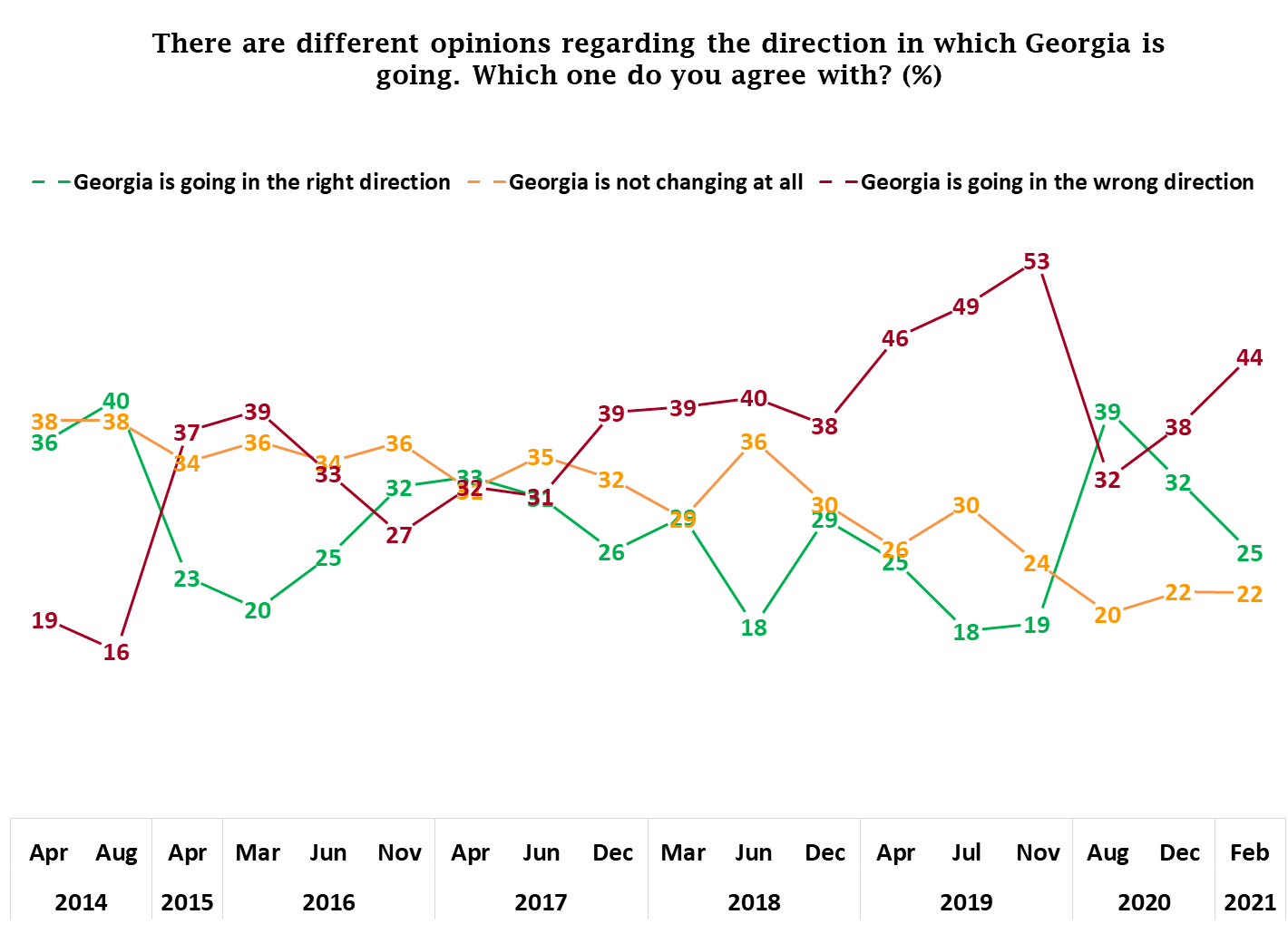
Whether one considers themselves to be a supporter of Georgian Dream or not appears to be the single biggest factor in their view that Georgia is ‘heading in the right direction’ or not.
The share of the public thinking the country is going in the wrong direction has fluctuated dramatically over the years. But which groups have been more or less pessimistic over time remains an open question. The merged dataset of NDI and CRRC Georgia surveys from 2014 to 2021 suggests that throughout the fluctuations in attitudes, the largest determinant of whether people are pessimistic or optimistic about the direction the country is headed in is the party they support.
Fluctuations in views of where the country is headed
Georgians’ views of where the country is headed have fluctuated together with Georgia’s often turbulent social, political, and economic situation.
The devaluation of the Georgian lari, starting in November 2014, is concomitant with the decline in views of the country’s direction between August 2014 and April 2015. Negativity continued to rise in the next wave of the survey in November 2015. From this point, negativity in views of the country’s direction declined until November 2016. After a slight uptick in negativity between June and December 2017, negative attitudes were largely stable between 36% and 39% until April 2019.
From April 2019, the level of negativity in the country steadily climbed, reaching 53% of the public viewing the country’s direction negatively in December 2019. The period between April 2019 and December 2019 coincides with the large-scale protests over the visit of Russian politician Sergei Gavrilov as well as subsequent failures to deliver promised reforms.
In the first post pandemic survey in August 2020, the rate of negativity dropped to 32%. This likely stems from Georgians’ positive assessments of the Government’s handling of the COVID-19 crisis.
However, the three NDI surveys since suggest that this lull in negativity has receded, with 44% of the public thinking that the country is headed in the wrong direction and only 25% in the right direction as of February 2021. Increased pessimism likely stems from the political crisis which followed the October 2020 elections, and has only recently been largely, though not fully, resolved.
What predicts pessimism and optimism?
While the above highlights major fluctuations in attitudes towards the country’s direction, a key question remains: which groups in society are more or less pessimistic?
People in Tbilisi and other urban areas are eight and five percentage points more likely to agree with the idea that Georgia is going in the wrong direction than people in rural areas.
People who have secondary technical or a lower level of education are two to four percentage points more pessimistic than those with higher education.
People who do not have a job are three percentage points more likely to report that the country is going in the wrong direction.
Above and beyond all of the above, which party someone supports is the best predictor of whether someone thinks the country is headed in the right or wrong direction. Opposition party supporters are 34 percentage points more likely to have a negative view of where the country is headed, on average, controlling for other factors. Those who support no party are 21 percentage points more likely to have a negative view of where the country is headed.

Aside from being the best overall predictor, supporting an opposition party or no party predicts views about the country’s direction for each wave of the survey when analysed independently. And while the influence of party support as a predictor has fluctuated over time, it has been increasing overall.
In April 2014, supporters of the ruling Georgian Dream party were 5 percentage points less likely to think the country was going in the wrong direction compared to supporters of no party. Opposition supporters were 22 percentage points more likely than Georgian Dream party supporters to think the country was going in the wrong direction.
The gap in views has fluctuated, but increased overall. In February 2021, Georgian Dream supporters were 46 percentage points less likely to think the country was going in the wrong direction compared to opposition supporters, a 24 percentage points increase in the gap in perceptions. Similarly, the gap in perceptions rose by 23 percentage points between Georgian Dream supporters and non-partisans. The changes in the gap between Georgian Dream and supporters of the opposition and non-partisans are also highly correlated (a 78% correlation between the two sets of marginal effects). These data taken together suggest a widening gap between the perceptions of Georgian Dream supporters and everyone else in Georgia.

As assessments of Georgia’s direction have changed over time, several factors have been associated with relatively minor differences in views of where the country is headed. While demographics explain some of the variation in people’s views, the party people support explains more than all of the other factors combined. Whether this is caused by supporting a given party or whether people change their party when their views of the country’s direction change is an open question. What the data do suggest though is that there is a widening gap between the perceptions of Georgian Dream supporters and everyone else in society.
Note: The above analysis is based on a logistic regression, where the dependent variable is a negative assessment of the country’s direction, and the independent variables include gender, age, settlement type, education, employment status, partisanship, and survey wave.
The views presented in the article are the author’s alone, and do not necessarily reflect the views of CRRC Georgia, NDI, or any related entity.









